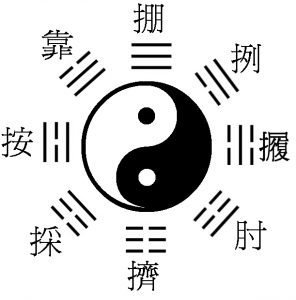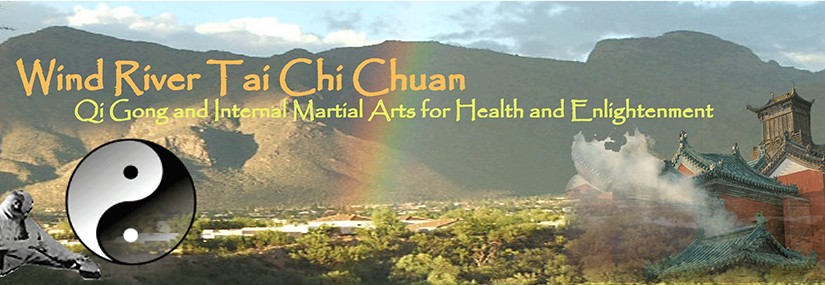The Many Faces of Tai Chi Chuan
 Tai Chi Chuan as we know it today has changed and evolved over a long evolution of Chinese history. Tai Chi evolved from ancient Taoist mystical practices designed to assisting practitioners in their search for longevity and enlightenment. From the beginnings of early Taoist philosophy these adepts began using exercises closely based on the movement and spirit of animals that represented power, longevity and wisdom. Around 300AD a set of 5 animal movements evolved and were practiced by the Taoist adepts in their efforts to strengthen and align their minds and bodies with the natural elements of our world. Even before the 5 Animal Practice the adepts used several methods of meditative standing practices to bring them into natural alignment with the world around them. They stood silently for long periods of time allowing them to observe the life of nature surrounding them. Today, many practice this same standing meditation, Zhan Zhuang, and have found that through this stillness of body and mind the wildlife around them isn’t disturbed allowing them to observe many natural interactions of the animals around them.
Tai Chi Chuan as we know it today has changed and evolved over a long evolution of Chinese history. Tai Chi evolved from ancient Taoist mystical practices designed to assisting practitioners in their search for longevity and enlightenment. From the beginnings of early Taoist philosophy these adepts began using exercises closely based on the movement and spirit of animals that represented power, longevity and wisdom. Around 300AD a set of 5 animal movements evolved and were practiced by the Taoist adepts in their efforts to strengthen and align their minds and bodies with the natural elements of our world. Even before the 5 Animal Practice the adepts used several methods of meditative standing practices to bring them into natural alignment with the world around them. They stood silently for long periods of time allowing them to observe the life of nature surrounding them. Today, many practice this same standing meditation, Zhan Zhuang, and have found that through this stillness of body and mind the wildlife around them isn’t disturbed allowing them to observe many natural interactions of the animals around them.
 From the 5 Animal Practice the Taoist adepts developed the 3 Chinese Internal Martial Arts; Tai Chi Chuan, Bagua Chuan and Xing Yi Chuan. This wasn’t a rapid development but took place over 100s of years. In the case of Tai Chi Chuan it began with the adepts following the movements arising from within their meditations into various postures. In Tai Chi Chuan there are 13 basic postures all designed to facilitate one’s natural movement and journey towards health and enlightenment.
From the 5 Animal Practice the Taoist adepts developed the 3 Chinese Internal Martial Arts; Tai Chi Chuan, Bagua Chuan and Xing Yi Chuan. This wasn’t a rapid development but took place over 100s of years. In the case of Tai Chi Chuan it began with the adepts following the movements arising from within their meditations into various postures. In Tai Chi Chuan there are 13 basic postures all designed to facilitate one’s natural movement and journey towards health and enlightenment.
In the 13th century a Taoist monk, Chan San Feng codified many of the postures into forms of Tai Chi Chuan.
As Tai Chi’s development continued the masters began aligning the postures with the 8 basic Trigrams of the I Ching using both pre-heaven and post-heaven arrangements. Additionally, the concepts from the Tai Chi Symbol were taken into account as they refined their practices.
 Eventually, Taoist masters in a direct lineage from Chang San Feng began teaching the martial masters of Chen Village, who already were highly adept with their own family style of martial arts. It is from this joining of two arts that Tai Chi Chuan began to resemble what we see and know today. There are many different legends and stories that explain this history and so it is today a murky past of beginnings. However, we do know that Yang Lu Chan, as an outsider to the Chen family possibly learned the art that was passed to them by Chang San Feng’s tai chi descendent.
Eventually, Taoist masters in a direct lineage from Chang San Feng began teaching the martial masters of Chen Village, who already were highly adept with their own family style of martial arts. It is from this joining of two arts that Tai Chi Chuan began to resemble what we see and know today. There are many different legends and stories that explain this history and so it is today a murky past of beginnings. However, we do know that Yang Lu Chan, as an outsider to the Chen family possibly learned the art that was passed to them by Chang San Feng’s tai chi descendent.
Yang Lu Chan, after mastering what he had been taught traveled to Beijing and eventually through himself and his descendants brought Tai Chi Chuan to the world. As the art evolved and spread in popularity so did the variations from the Yang Family style. From Yang Tai Chi evolved Wu and Sun Tai Chi Chuan, however it wasn’t until the 1940s or so that anyone actually used these names to differentiate, as up to that point it was simply Tai Chi Chuan.
Finally, Tai Chi Chuan has undergone many transformations in how it was practiced, taught and used, from its beginnings as a more meditative path to a highly effective Martial Art and back. Tai Chi today is often practiced in both formats, but those who truly understand the internal martial aspects of Tai Chi Chuan may be growing smaller with each passing year.
The above summary is simply my take on the many faces of Tai Chi Chuan and of course, a very generalized and shortened version of its history. If you are interested in learning more details our links and resources section in this site should help you get started.
